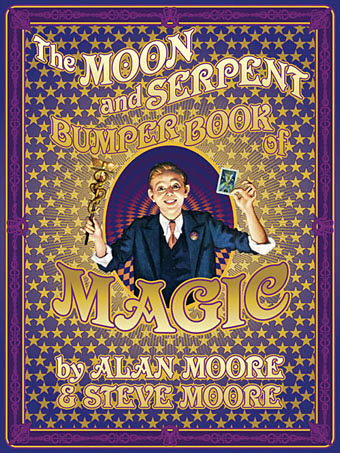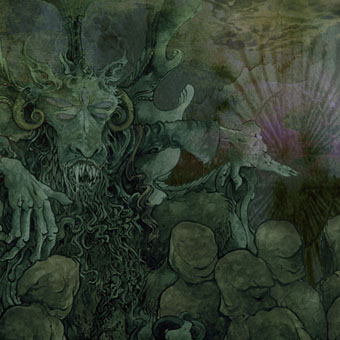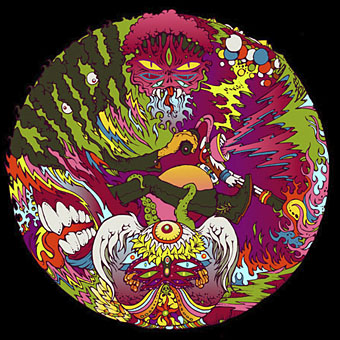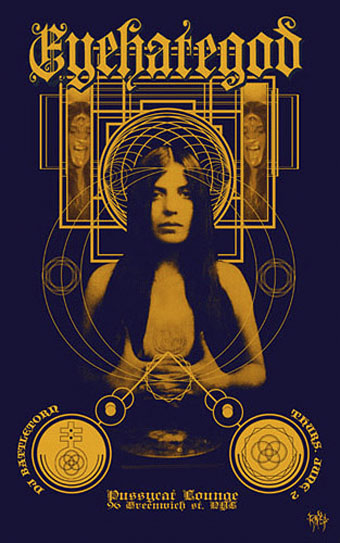
It’s lunar, it’s serpentine, it’s grandly thaumaturgical. Cover design by yours truly.
Via Top Shelf:
Splendid news for boys and girls, and guaranteed salvation for humanity! Messrs. Steve and Alan Moore, current proprietors of the celebrated Moon & Serpent Grand Egyptian Theatre of Marvels (sorcery by appointment since circa 150 AD) are presently engaged in producing a clear and practical grimoire of the occult sciences that offers endless necromantic fun for all the family. Exquisitely illuminated by a host of adepts including Kevin O’Neill, Melinda Gebbie, John Coulthart, José Villarrubia and other stellar talents (to be named shortly), this marvelous and unprecedented tome promises to provide all that the reader could conceivably need in order to commence a fulfilling new career as a diabolist.
Its contents include profusely illustrated instructional essays upon this ancient sect’s theories of magic, notably the key dissertation “Adventures in Thinking” which gives reliable advice as to how entry into the world of magic may be readily achieved. Further to this, a number of “Rainy Day” activity pages present lively and entertaining things-to-do once the magical state has been attained, including such popular pastimes as divination, etheric travel and the conjuring of a colourful multitude of sprits, deities, dead people and infernal entities from the pit, all of whom are sure to become your new best friends.
Also contained within this extravagant compendium of thaumaturgic lore is a history of magic from the last ice-age to the present day, told in a series of easy-to-absorb pictorial biographies of fifty great enchanters and complemented by a variety of picture stories depicting events ranging from the Paleolithic origins of art, magic, language and consciousness to the rib-tickling comedy exploits of Moon & Serpent founder Alexander the False Prophet (“He’s fun, he’s fake, he’s got a talking snake!”).
In addition to these manifold delights, the adventurous reader will also discover a series of helpful travel guides to mind-wrenching alien dimensions that are within comfortable walking distance, as well as profiles of the many quaint local inhabitants that one might bump into at these exotic resorts. A full range of entertainments will be provided, encompassing such diverse novelties and pursuits as a lavishly decorated decadent pulp tale of occult adventure recounted in the serial form, a full set of this sinister and deathless cult’s never-before-seen Tarot cards, a fold-out Kabalistic board game in which the first player to achieve enlightenment wins providing he or she doesn’t make a big deal about it, and even a pop-up Theatre of Marvels that serves as both a Renaissance memory theatre and a handy portable shrine for today’s multi-tasking magician on the move.
Completing this almost unimaginable treasure-trove are a matching pair of lengthy theses revealing the ultimate meaning of both the Moon and the Serpent in a manner that makes transparent the much obscured secret of magic, happiness, sex, creativity and the known Universe, while at the same time explaining why these lunar and ophidian symbols feature so prominently in the order’s peculiar name. (Manufacturer’s disclaimer: this edition does not, however, reveal why the titular cabal of magicians consider themselves to be either grand or Egyptian. Let the buyer beware.)
A colossal and audacious publishing triumph of three hundred and twenty pages, beautifully produced in the finest tradition of educational literature for young people, The Moon and Serpent Bumper Book of Magic will transform your lives, your reality, and any spare lead that you happen to have laying around into the purest and most radiant gold.
A 320-Page Super-Deluxe Hardcover, co-written by Alan Moore and Steve Moore, and illustrated by various luminaries from the comic book field.
Cover design by John Coulthart.
A 2009 RELEASE!
ISBN 978-1-60309-001-8







